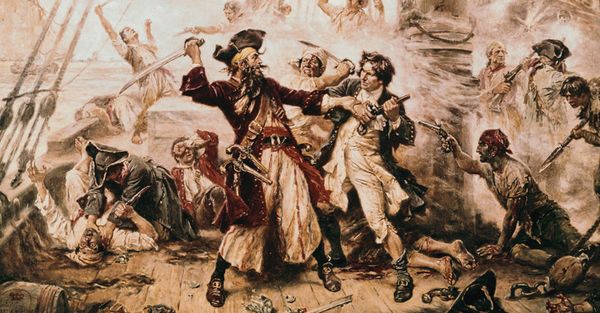For years, Mrs. Cheng maintained good relationships with the leaders of every fleet in the coalition. She ran a tight ship (so to speak) and oversaw everything from monetary transactions to religious ceremonies.
On her watch, the pirate alliance expanded like crazy. Of the 270 government-owned ships stationed at Tien-Pai, 266 fell under her control. By demanding regular patronage from sailing merchants, Mrs. Cheng's sailors profited off Canton's lucrative salt trade. As a matter of fact, the outlaws extracted so much revenue across their domain that Mrs. Cheng found it necessary to establish a network of land-based financial offices.
Her strategic mind was well-suited to warfare. Mrs. Cheng's fleets regularly embarrassed the navies of southern China. They grew notorious for kidnapping Chinese officials, blockading rivers and routing just about anybody who opposed their will. But that was to change.
In 1809, China's increasingly agitated government borrowed well-armed vessels from the British East India Company and the Portuguese Navy. At the same time, it also offered amnesty to pirates who surrendered.
"The offer was tempting to the leader of the Black Flag Fleet, who then forced a confrontation with the Red Flag Fleet," Murray says. While negotiating with the government, he turned over the captives from that inter-squadron battle as a gesture of goodwill. Before long, other units were defecting from Mrs. Cheng's confederation.
She could read the writing on the wall. Blackbeard and other career pirates who kept plundering until the bitter end usually met horrible deaths, whether on the high seas or at the gallows. Mrs. Cheng decided to go a different route.
On April 8, 1810 — after an earlier round of peace talks failed — she took a delegation of 17 pirate wives and children to the governor-general's office in Canton. Inside, Mrs. Cheng brokered a favorable amnesty deal. "[Chang Pao] was allowed to retain between 20-30 of his vessels for use in the salt trade and received an appointment in the Chinese water forces," Murray tells us. Most of the pirates who'd served under her were granted pardons as well.
Chang Pao passed away in 1822 at 36. He was survived by his brilliant wife, who died peacefully in 1844 at the age of 69.



